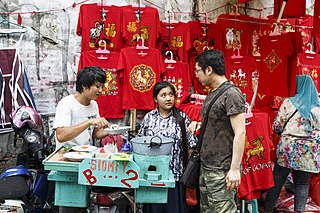
American Chinese cuisine is a cuisine derived from Chinese cuisine that was developed by Chinese Americans. The dishes served in many North American Chinese restaurants are adapted to American tastes and often differ significantly from those found in China.

Chow mein is a dish of Chinese stir-fried noodles with vegetables and sometimes meat or tofu. Over the centuries,variations of chǎomiàn were developed in many regions of China;there are several methods of frying the noodles and a range of toppings can be used. It was introduced in other countries by Chinese immigrants. The dish is popular throughout the Chinese diaspora and appears on the menus of most Chinese restaurants abroad. It is particularly popular in India,Nepal,the UK,and the US.

Indonesian cuisine is a collection of various regional culinary traditions that formed in the archipelagic nation of Indonesia. There are a wide variety of recipes and cuisines in part because Indonesia is composed of approximately 6,000 populated islands of the total 17,508 in the world's largest archipelago,with more than 1,300 ethnic groups.

Fried rice is a dish of cooked rice that has been stir-fried in a wok or a frying pan and is usually mixed with other ingredients such as eggs,vegetables,seafood,or meat. It is often eaten by itself or as an accompaniment to another dish. Fried rice is a popular component of East Asian,Southeast Asian and certain South Asian cuisines,as well as a staple national dish of Indonesia. As a homemade dish,fried rice is typically made with ingredients left over from other dishes,leading to countless variations. Fried rice first developed during the Sui dynasty in China.

Trinidad and Tobago has a unique history and its food is influenced by Indian-South Asian,West African,Creole,European,American,Chinese,Amerindian,and Latin American culinary styles. Trinidadian and Tobagonian food is dominated by a wide selection of dishes,most notably,doubles,roti,pelau,callaloo and curried crab and dumplings. Trinidad and Tobago is also known for its prepared provisions,such as dasheen,sweet potato,eddoes,cassava,yam,soups and stews,also known as blue food across the country. Corresponding to the Blue Food Day event held annually in Trinidad and Tobago.

Fu rong dan is an omelette dish found in Chinese cuisine. The name comes from the Cantonese language. Egg foo young is derived from fu yung egg slices,a mainland Chinese recipe from Guangdong.

Noodle soup refers to a variety of soups with noodles and other ingredients served in a light broth. Noodle soup is a common dish across East Asia,Southeast Asia and the Himalayan states of South Asia. Various types of noodles are used,such as rice noodles,wheat noodles and egg noodles.

Chinese Indonesian cuisine is characterized by the mixture of Chinese with local Indonesian style. Chinese Indonesians,mostly descendant of Han ethnic Hokkien and Hakka speakers,brought their legacy of Chinese cuisine,and modified some of the dishes with the addition of Indonesian ingredients,such as kecap manis,palm sugar,peanut sauce,chili,santan and local spices to form a hybrid Chinese-Indonesian cuisine. Some of the dishes and cakes share the same style as in Malaysia and Singapore,known as Nyonya cuisine by the Peranakan.

Rice vermicelli is a thin form of noodle. It is sometimes referred to as "rice noodles" or "rice sticks",but should not be confused with cellophane noodles,a different Asian type of vermicelli made from mung bean starch or rice starch rather than rice grains themselves.

Fried noodles are common throughout East Asia,Southeast Asia and South Asia. Many varieties,cooking styles,and ingredients exist.

Korean Chinese cuisine,also known as Sino–Korean cuisine,is a hybrid cuisine developed by the ethnic Chinese in Korea.

Peranakan cuisine or Nyonya cuisine comes from the Peranakans,descendants of early Chinese migrants who settled in Penang,Malacca,Singapore and Indonesia,inter-marrying with local Malays. In Baba Malay,a female Peranakan is known as a nonya,and a male Peranakan is known as a baba. The cuisine combines Chinese,Malay,Javanese,South Indian,and other influences.

Japanese Chinese cuisine,also known as chūka,represents a unique fusion of Japanese and Chinese culinary traditions that have evolved over the late 19th century and more recent times. This style,served predominantly by Chinese restaurants in Japan,stands distinct from the "authentic Chinese food" found in areas such as Yokohama Chinatown. Despite this difference,the cuisine retains strong influences from various Chinese culinary styles,as seen in the shippoku cooking style.

Shumai is a type of traditional Chinese dumpling made of ground pork. In Cantonese cuisine,it is usually served as a dim sum snack. In addition to accompanying the Chinese diaspora,variations of shumai are found in Japan and Southeast Asia,such as the Indonesian siomay. In Australia,it developed into dim sim.

Chinese fried rice is a family of fried rice dishes popular in Greater China and around the world. It is sometimes served as the penultimate dish in Chinese banquets,just before dessert.

Manipuri cuisine refers to the cuisine of Manipur,a state of northeastern India. Daily meals are based on rice,with a few side dishes of vegetables,fish and meat. A meal would usually have a vegetable stew called ensaang or athongba,flavored with dried or fried fish;stir-fried vegetables called kanghou;and a spicy item,which could be morok metpa,eromba,or singju. All piquant side dishes are accompanied by a choice of fresh herbs,collectively called maroi. The base and essence of Meitei cuisine is the fermented fish called ngari. Several dishes of meat,mostly chicken and pork,are cooked with unique recipes. As a result of religious taboos,however,the Meitei Pangals do not cook the latter.















